Our home doesn’t have an attic. There are exposed rafters above the garage, though, so we store our extra junk up there. A couple of years ago flakes of plastic began to drift down onto the garage floor. The flakes, which are still coming down, are from garment bags I put up there 21 years ago. Garment bags containing US Air Force uniforms dating from 1973 to 1997. The bags are rotting away and the uniforms by now are likely moth-eaten and discolored. At some point I’m going to have to get up there to see what can be salvaged … but not now.
I know my Class A uniform is up there, literally the last one I wore:

I don’t think of myself as a conformist, although I served on active duty and wore a uniform every day for 24 years. Even today, I feel proud when I put on my uniform shirt to go work at the air museum. I’m still me, but I’m happy to represent institutions I believe in and voluntarily join, and feel like wearing their colors … no different than a Hash House Harrier or Hells Angel … sets me apart.
When I started thinking about this post, I tried to Google photos of the various uniforms I wore during my career, especially the ones that have been phased out and forgotten. Turns out it’s hard to find good photos of old Air Force uniforms! About the only good source is eBay, where people sell their parents’ relics, and those photos are too often out-of-focus thumbnails.
Heres what I remember: in 1973 the day-to-day uniform in good weather was tan-covered trousers and an open-collar tan short-sleeved shirt with enlisted rank on the sleeves and officer rank on the collar. We called them 1505s, which was the USAF designation for the shade of tan. With our 1505s we wore black shoes, a dark blue belt, and a dark blue bivouac hat (also called a flight cap).
The tan uniform combo was later replaced by the one you mostly see today: dark blue trousers and belt with a light blue open-collar short-sleeved shirt. I recall also wearing the same combo with a long-sleeved light blue shirt, but with that one you had to button the collar and wear a dark blue tie.


I’m with my Officer Training School classmate John Orr in the top photo. He’s wearing 1505s; I’m in a bag. As cadets, we wore our rank on shoulder epaulets. We were both “cadet captains” at that point in training, but really we were staff sergeants, and had we washed out we’d have had to serve out our enlistment at that rank. The bottom photo shows Donna pinning me on OTS graduation day. We wore the light blue short-sleeved shirt combo for graduation, and because tradition demanded we throw our hats in the air when the general announced our new status as second lieutenants, we wore wheel hats, which fly almost as well as Frisbees.
The light blue short-sleeved shirt combo co-existed with the tan 1505 combo for the first couple of years I served, but then the tans were phased out. In addition to the short-sleeved blue shirt, you could also wear a long-sleeved light blue shirt, but with that one you had to button the collar and put on a dark blue tie.
I’m pretty sure the tropical uniform combo was still authorized when I joined up: tan shorts, shirt, and long socks. It was optional, though, and I never had one. I don’t remember that crazy hat, though … this may be a photo of an older tropical combo from the 1950s:
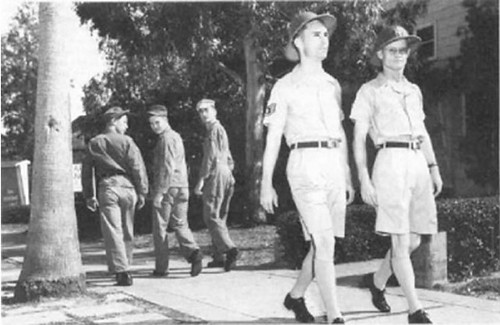
Class As, like those I’m wearing in the photo at the top of this post, are for dress-up occasions: dark blue trousers, light blue long-sleeved shirt, and the dark blue blouse with your name tag, rank, devices, and ribbons. With it you wear a dark blue tie and wheel hat. If you have to go out in the cold, there’s a dark blue wool overcoat that comes down to your knees, also called a peacoat.
My favorite combo was one we called the Captain Midnight: dark-blue trousers and a matching long-sleeved shirt you wore with a dark blue necktie (by the way, the dark blue uniform color used by the USAF is called “midnight blue”). Captain Midnights were phased out sometime in the 1980s, and I was sorry to see them go. Alas, photos of that one elude my extensive online search.
As a pilot, I spent two-thirds of my career in green Nomex flight suits, which we called bags. At first, flight suits were only to be worn in the flying squadron and when actually flying. When we went elsewhere on base, or any time we went off base, we were supposed to change into what they called the “uniform of the day,” but over the years enforcement became lax and by the early 1990s the only time I wore a regular uniform was for official photos and ceremonial occasions.
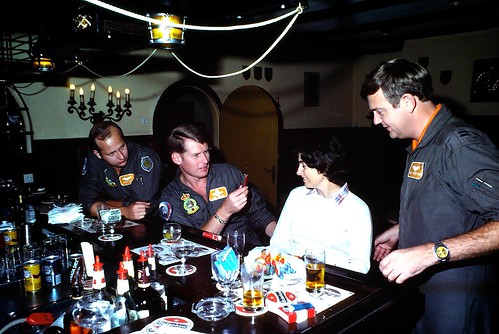
For the first half of my career, the jacket I wore with the flight suit was a highly flammable satiny thing with an international orange lining (you could wear it inside out so rescue crews could see you down in the jungle below). In the late 1980s the USAF, desperate to boost morale and stem the mass exodus of pilots to the airlines, began to issue WWII-style leather jackets. Those were super-fine and I still wear mine today, nametag and all.
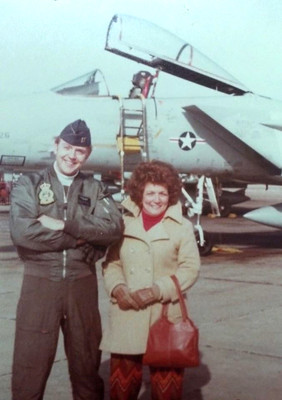

As with other uniformed professions, your first uniforms are issued to you. Replacements, extras, and new uniform combos come out of your pocket. For officers, every time a new and different uniform combination replaced one that had been phased out (or was added out of the blue on the whim of a four-star general), we had to shell out for it. Two such were the blue and white ceremonial dress uniforms that became required items for officers in the 1980s, ordered by then-Chief of Staff General Gabriel (but really, rumor had it, by Mrs Gabriel). These were not uniforms most officers would ever have occasion to wear, and few bought them. Alas, I had a prized slot to the prestigious Armed Forces Staff College, a Navy-run school in Norfolk, Virginia where they trained field grade officers from different service branches to play well together. It just so happened my class was scheduled to start in the spring and graduate in the winter … which meant I had to wear the whites for the welcoming ceremony and the blues for graduation.
I wasn’t able to find a photo of the blue ceremonial uniform, but I did find one of the whites, aka the Good Humor Man suit. Notice the shoes, which we also had to buy, and which could never be worn with anything else (at least with the ceremonial blues, you wore your regular black ones). There was a white wheel hat too, of course, and a blue one that was just different enough from the normal one that it, as with the white shoes, could never be worn with anything else.

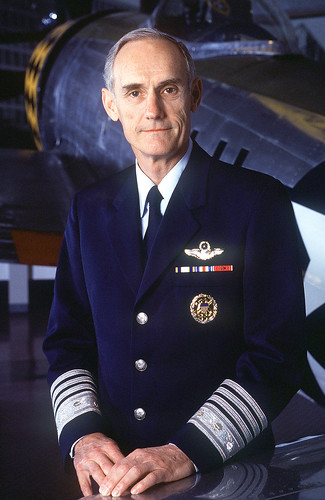
In the 1990s another chief of staff, General Tony McPeak, replaced the traditional officers’ Class A uniform with one bearing Navy-style sleeve rank. This caused a bit of a revolt in the ranks and was phased out the day after McPeak retired, but not before I had to buy and wear one for a promotion board photo. That’s wanna-be Admiral McPeak in the second photo. As a lieutenant colonel, I wore Navy commander rank, three 1/2″ silver braid stripes on the sleeve.
I can’t leave out the mess dress uniform, semi-formal wear for dining ins and dining outs (dining ins are for military members only, no spouses; dining outs are the ones where you bring spouses and guests … the way I remembered the difference was “in crowd” and “out crowd”). I should mention that there’s a formal tuxedo-style uniform (I think it even has tails), but the only airmen who ever have occasion to wear it are White House aides and air attachés). Dining ins especially are rowdy affairs, and over the years I had to buy several new mess dress uniforms to replace ones damaged with cigar burns and wine stains. They aren’t cheap, and you have to pop for a tailor to get them to fit properly. They come in white and black, and luckily I have photos of each, wearing the white one for my pilot training graduation dining-out and the black one for a USMC birthday ball at NAS Norfolk in 1985:

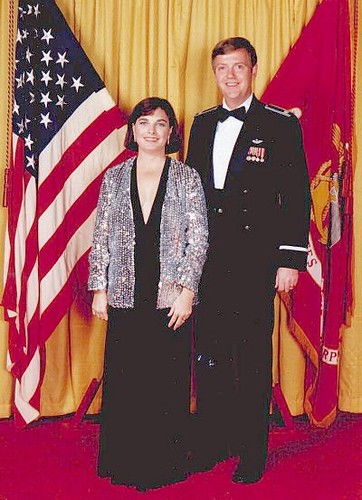
You wore medals and ribbons on some uniform combos; just a name tag, rank, and wings (if you had them) on others. Even that varied from time to time and from command to command. Generally, though, you wear ribbons on your Class A blouse and miniature medals on formal and semi-formal uniforms. When you’re awarded a medal, they give you a box containing the full-sized medal and the ribbon that represents it. I don’t know when or where you’d ever wear the big medal, other than at the ceremony when they pin it on you … the only ones I ever wore were the miniature versions, and those only on my mess dress uniforms. When I first started out and had only one or two, I’d buy a little metal bar at the base military clothing sales store and arrange my own ribbons in the proper order. Medals too. Twenty-four years later I had five rows of ribbons and two rows of medals, and like every other officer I knew, paid commercial vendors to arrange and mount them correctly, another out-of-pocket expense. A lot of retirees display their medals and ribbons in shadow box frames, but mine are still on my last Class A uniform blouse and mess dress jacket, up in the garage rafters.
I’m leaving a lot out. The plain green fatigues you see in old Korean and Vietnam war photos had been phased out just before I joined, replaced by camouflage fatigues. I owned a set but never had occasion to wear them. They were replaced by a multi-service battle dress uniform in the 1980s. I wore those BDUs to work every day when I was on the joint staff at US Special Operations Command, where to align with the Army and Marines we rolled our sleeves up (regular Air Force pukes had to keep the sleeves rolled down). Today, each service has its own version of BDUs with distinct camouflage patterns, although a friend tells me the services are once again adopting a common BDU.
There was a dark blue fabric jacket for wear with the short- and long-sleeved light blue shirt combo, and over the years different kinds of sweaters (an optional item I never wore myself). There was a raincoat, dark blue of course, and different head coverings for severe weather (I still have the fleece-lined green skullcap with pull-down ear flaps and the black wool balaklava issued to me in Alaska). I used to have a pair of inflatable “bunny boots” and an Arctic parka with a hoodie lined in wolf hair … today the hair is synthetic. It may have been an Alaskan Air Command-only thing, but in the mid-1980s they issued felt-lined Sorel boots to the pilots, and I still have mine … I think it’s safe to say I’ll never need them here in Arizona.
One last thing to note in passing: Army Air Force officers in WWII wore an iconic Class A uniform called “pinks and greens.” That was one sharp uniform, and what really set if off was the belted blouse. I hear the USAF is getting ready to adopt a retro Class A uniform design featuring a belted blouse. It’s blue of course, but for what it’s worth, I’d have been happy to wear one when I was in.


p.s. My apologies for not addressing women’s uniforms, but I don’t know enough about the various combos they wore during my career to do the subject justice.
Update (9/11/19): reorganized some paragraphs and added two photos I was looking for but couldn’t find when I first wrote this post.
Fun piece. Thanks! My Dad was a prof at Texas A&M mid ’60’s. While our family was getting ready for the school day, the radio had news, weather and uniform of the day orders for the cadets. We kids thought it was kind of odd, but got used to it. I was gifted with one year of high school at US air base west of Paris ’64 (De Gaulle kick US out in ’65) 1966 at Torrejon Air Base (SAC) outside Madrid. Got to experience a lot of USAF stuff as a minor non-combatant. They lost that nuke in the Med while I was there.
Robert, thanks for the fascinating comment. Now you’ve got me wondering how the uniform of the day was announced at the different bases I was assigned to. I think it was posted on bulletin boards at most of them, but can’t really remember.
BTW Some detail may be fun,
The base in France was built in early ’40’s by German to attack England and originally had a grass runway. It was called Dreux Air Base, a few miles NW was a sister, larger base called Everuex Air Base. Can’t recall the units stationed there but will explore Google. No serious maintenance occurred between ’44 and ’64 other than concrete runway and new hangers.. The school’s gym/showers were held up by structural-grade mold with mildew reinforcing. Rainy days PE was isometrics in an upstairs room. Dorms (M & F) were clearly set up for original occupants. We had local French people working janitorial, grounds, mess hall etc. A survivor of the (real) Great Escape came and gave a talk about the event.
Just a bit more:
Dreux Air Base and Torrejon SAC Base both had schools for US dependents and fielded sports teams to compete with other US bases in Europe. Torrejon was much newer, built in early ’60’s. All buildings were brick with flat roofs. Larger base and larger US population. Great access to Madrid for all the amenities of a large, capitol city. At Dreux, rare access to Paris. No indigenous military personnel on either air base other than gate guards as I recall. Funny – a visitor came to our dorm once to discuss and demonstrate how to be a matador. He was Irish. Saw one bull fight, too bloody for Americans. We met and roomed with kids from all over southern Europe to mid-east and Africa. Spanish were way cooler folks than the French.
I was a military brat myself. Went to 3rd, 4th, 5th grades at Ramstein AB, 1955-1958. I vaguely remember classes were held in temporary buildings … a lot of Ramstein was still under construction back then. My own kids were brats in the Netherlands and Japan. I know they have lots of stories to tell.